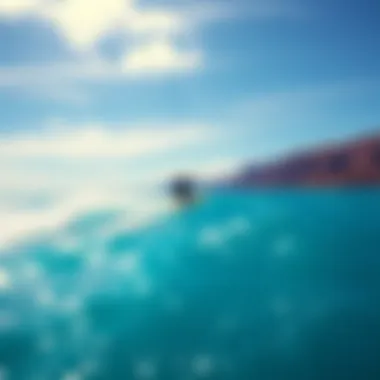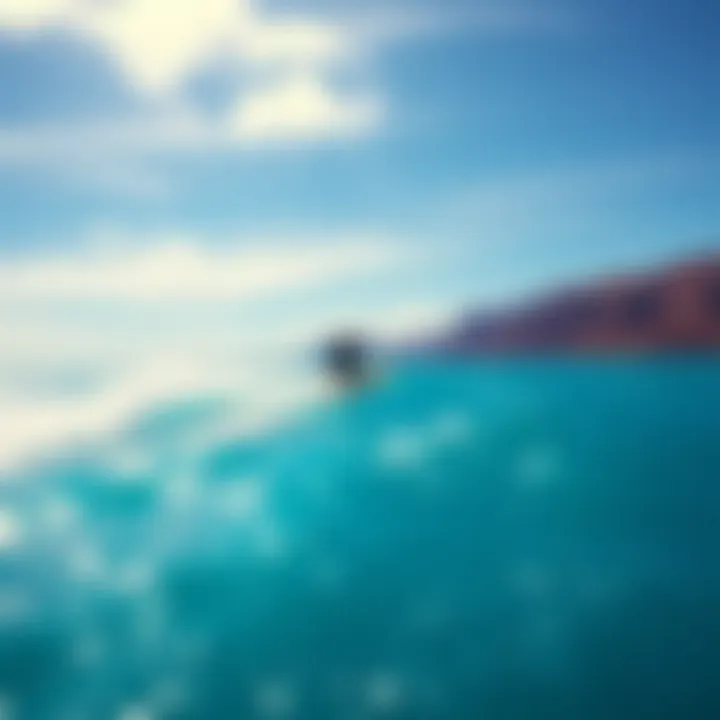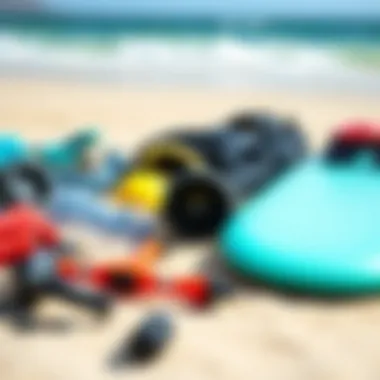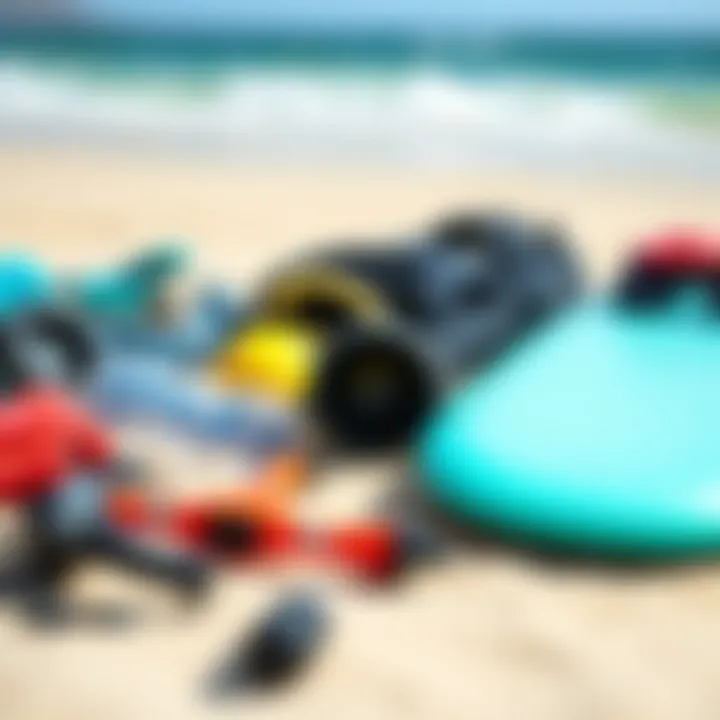Kite Surfing in Maui: Your Ultimate Guide


Intro
Kite surfing in Maui isn’t just a sport; it’s a way of weaving oneself into the very fabric of this vibrant landscape. Picture yourself gliding across bluish waves with the soft breeze at your back while the sun dips low on the horizon. Diving into this exhilarating activity requires more than just a love for the ocean. It entails an understanding of gear, locations, safety, and techniques that can either make or break your experience.
Maui boasts a kaleidoscope of kite surfing spots, ranging from gentle shores perfect for beginners to windswept areas where seasoned pros push their limits. This guide sets out to unpack this thrill, mapping out the necessary tools, the ideal places to practice, and essential tips to keep you and your gear safe while you dance with the wind.
By the end of this article, you’ll be equipped not just with the information needed to embark on your kite surfing journey, but also with a sense of belonging in Hawaii’s kiteboarding community.
Gear Insights
A successful kite surfing experience begins with the right equipment. The right gear does more than just enhance performance; it can make you feel more confident and secure on the water.
Latest Gear Reviews
When it comes to gear, it’s crucial to stay updated. Brands like Duotone, Naish, and Cabrinha have recently launched some cutting-edge models that are worth considering. For instance, the Duotone Rebel is well-regarded for its versatility and performance, making it favorable across different wind conditions. Reviews frequently highlight its responsiveness, ensuring smooth handling whether you're launching into the air or cruising close to the shore.
Another notable mention is the Cabrinha Switchblade, popular for beginner and advanced riders alike. Its impressive stability allows new kiteboarders to gain confidence while not sacrificing performance for the seasoned ones.
"The right kite can transform a challenging day into an exhilarating ride."
Essential Gear for Beginners
For those just starting their kite surfing journey, certain items are essential to ensure a more enjoyable and safer experience:
- Kite: A medium-sized inflatable kite (between 10m to 12m) is ideal.
- Board: A twin tip board is suitable for beginners, as it provides balance and ease of handling.
- Harness: A comfortable, well-fitted harness is crucial as it distributes the pull from the kite.
- Safety Release: This device allows you to detach from the kite quickly in emergencies.
- Helmet and Impact Vest: These protective gear options are highly recommended for safeguarding against falls.
Understanding these basics allows newcomers to hit the waters with confidence and enthusiasm.
Techniques and Tips
Mastering kite surfing involves more than just getting your gear sorted. It requires consistent practice and learning from every session.
Advanced Tricks and Techniques
Once you're comfortable riding, you might want to learn tricks like jumps or transitions. A key technique is the edge control—this is all about angling your board while riding. The more offset your board is to the wind, the more lift you can generate. Applying this while timing your jump can produce a beautiful aerial sail.
Safety Practices for Kiteboarders
Safety cannot be emphasized enough in kite surfing. Here are some vital practices:
- Check Weather Conditions: Always be aware of the wind patterns and forecast.
- Practice Self-Rescue Techniques: Educate yourself on how to manage situations when control is lost.
- Buddy System: Always kite with a partner; it’s not just more fun, it also adds a layer of safety.
- Respect Local Regulations: Each spot might have its own set of rules. Familiarize yourself to ensure compliance and safety.
By embracing these techniques and prioritizing safety, kiteboarding can transform into one of the most rewarding experiences you’ll have on Maui’s glistening waters.
For more detailed navigation, you can refer to resources like https://www.reddit.com/r/Kitesurf> or visit local kite surfing schools for firsthand guidance.
In essence, kite surfing in Maui offers a rich tapestry of adventure, community, and skill. It’s not just about conquering the waves; it’s about the journey of growth and connection with nature.
Kite Surfing: An Overview
Kite surfing, often hailed as one of the most exhilarating water sports, encompasses a unique blend of surfing, windsurfing, and paragliding. This introduction sets the stage for a comprehensive examination of kite surfing in Maui, a tropical haven that draws enthusiasts from around the globe. The sport's integration into the Hawaiian landscape is not just about the thrill; it's about the culture, community, and connection to nature that kite surfers experience.
Definition and History
Kite surfing can be defined simply as harnessing the wind's power to propel oneself across the water on a surfboard. But that's a good way to put it simply. The roots of kite surfing can be traced back to the late 1970s and 1980s. Early pioneers experimented with kites for various sports, leading to the evolution of modern kite surfing as we know it today. The sport really took off in the 1990s, particularly in locations with ideal wind and water conditions, like Maui.
Maui has become synonymous with kite surfing, thanks to its consistent trade winds and stunning beaches. With its tropical vibe, it serves as both a playground and a training ground for newcomers and seasoned pros alike. The island’s reliable winds contribute to the community’s growth, making it a hotspot for kite surfing enthusiasts.
The Popularity Surge
In recent years, kite surfing has seen a surge in popularity, especially among younger generations seeking an adrenaline rush. Social media platforms such as Instagram and TikTok have played a significant role in this boom, allowing riders to showcase their skills and share their experiences. The visual appeal of the sport has attracted not only participants but also onlookers, generating interest and excitement around nearby beaches.
Moreover, the accessibility of kite surfing schools and rentals in areas like Maui has made it easier for individuals to get involved. The trend of adventure tourism means that many travelers want to not just see destinations, but also engage with them physically. For those looking to break away from traditional vacation activities, kite surfing offers a fresh and invigorating outlet.
"Kite surfing is not just a sport; it's a lifestyle that embodies the spirit of freedom and adventure."
As a sport that continually challenges its participants while also pushing the limits of human capability, kite surfing reflects a desire to embrace nature’s elements. With more local clubs and international competitions emerging, the kite surfing community in Maui continues to grow, fostering camaraderie and a shared love for the sport.
Why Choose Maui for Kite Surfing
Maui stands as a premier destination for kite surfing enthusiasts, merging the elements of adventure with the stunning backdrop of Hawaiian landscapes. This island is not just about breathtaking scenery; it offers conditions that cater to both novices and seasoned kiteboarders alike. Understanding the elements that make Maui a go-to spot for kite surfing enriches every rider's experience, facilitating informed choices in equipment and technique.
Ideal Climate for Kite Surfing
The climate in Maui plays a pivotal role in making it a kite surfing haven. With warm temperatures year-round, kite surfers can expect favorable conditions almost any time of the year. The trade winds, which blow consistently from the northeast, provide reliable wind patterns that are often steady—perfect for those looking to perfect their skills or just enjoy an afternoon on the water.
- Wind Conditions: The best months to catch the wind are typically from April to October, when the breezes are stronger and more consistent.
- Temperature: The air temperature hovers around 75 to 85 degrees Fahrenheit, making it comfortable for long hours of riding without chills.
With average wind speeds of 12 to 20 miles per hour depending on the season, the varied conditions across different beaches provide options for all levels. As the locals say, "When the east winds blow, kite surfers gather—it's time to play!" This phrase encapsulates the vibrant culture and camaraderie found among local kite surfers who thrive on the waves.
Cultural Significance of Water Sports in Hawaii
Hawaii's rich cultural fabric is steeped in water sports and a deep connection to the ocean. The islands have long been a sanctuary for water enthusiasts, with the sport of kite surfing becoming a significant aspect of this tradition. From racing canoes to paddleboarding, Hawaiians have long embraced water-based activities, making the transition to kiteboarding a natural progression.


The significance of water sports isn't just recreational; it's interwoven with community gatherings, environmental respect, and a sense of belonging. For example, many local kite schools emphasize not only skills training but also teaching about the protective measures needed to maintain marine environments.
- Community Events: Regular competitions and gatherings, like the Maui Kiteboarding Pro, illustrate the vibrant community spirit, encouraging both participation and spectator enjoyment.
- Connection to Nature: Water sports in Hawaii emphasize a profound respect for the ocean, encouraging riders to appreciate its beauty while also promoting sustainability.
In summary, the allure of Maui as a kite surfing destination lies in its ideal climate and deep-rooted cultural significance of water sports. The connection to the ocean and the shared experiences in this community enhance one’s time spent on the water, turning each session into a memorable adventure.
Top Kite Surfing Locations in Maui
When it comes to kite surfing, the location can make or break the experience. Maui stands out not just for its beautiful landscapes but also for its variety of kite surfing spots tailored to various skill levels and preferences. These locations are chosen for their wind conditions, safety, and the overall vibe, making them conducive for both newcomers and seasoned riders. Knowledge of these hotspots helps enthusiasts maximize their time on the water while ensuring a safe and enjoyable experience. Below, we dive deep into some powerhouse kite surfing locations.
Kanaha Beach Park
Kanaha Beach Park is often the first stop for those dipping their toes into the world of kite surfing. This beach promises more than just picturesque views; its steady trade winds and wide-open spaces create a paradise for kiteboarders. The launching area is vast, which mitigates the risk of crowding and allows riders ample room to take off and land.
Here are some key features of Kanaha Beach Park:
- Wind Conditions: Generally consistent winds blow from the east, ranging from 15 to 25 knots, which is optimal for both beginners and intermediates.
- Crowd Levels: While it can get busy, the size of the beach allows for a comfortable amount of space.
- Facilities: Public showers, restrooms, and picnic areas make it family-friendly.
For anyone starting out, it's a good idea to keep a keen eye on experienced riders. Observing and learning from local experts can be hugely beneficial. The park also offers kite surfing schools for those needing guidance.
Hookipa Beach
Hookipa Beach is famed amongst advanced kite surfers. Known for its more challenging conditions, it’s not for the faint-hearted. The waves here attract thrill-seekers looking to catch some serious airtime. With a reputation for being one of the best spots in the world, Hookipa has become synonymous with competitive kiteboarding.
Some distinctive features include:
- Wave Conditions: It presents diverse challenges with waves that can range from 4 to 10 feet, depending on the day. Perfect for more seasoned surfers.
- Spectating: If you’re not participating, watching the pros at Hookipa is genuinely breathtaking.
- Cultural Significance: The beach has historical value in Hawaiian culture, further enriching the experience beyond just sports.
Mid- to high-level riders must stay well within their ability levels here, keeping an eye on the changing tides and wind shifts.
Paia Bay
Another gem on the North Shore, Paia Bay, is frequently regarded as a laid-back spot, ideal for those adventure-seekers looking to kite surf in a relaxing environment. While still challenging, it’s relatively more accessible than Hookipa, making it favorable for those transitioning from beginner to intermediate levels.
Key highlights of Paia Bay include:
- Scenic Beauty: The beach is surrounded by lush landscapes, and the water is stunningly clear, making the experience enjoyable both in and out of the water.
- Convenient Amenities: Plenty of local eateries and shops are nearby, where cyclists can refuel.
- Safe Environment: The water is relatively shallow at the shoreline, allowing for safe crashes.
The blend of modern amenities and natural beauty makes Paia Bay an appealing option for kite surfers looking for a more social atmosphere compared to more intense spots.
West Maui Options
West Maui presents a slightly different vibe. With an array of kite surfing locations, it caters to those seeking variety without straying too far from convenience. Among the notable spots, you’ll find Kaanapali and Napili, which although not as popular as the aforementioned beaches, still hold great potential for kite surfing.
Several aspects to consider include:
- Particular Beaches: Kaanapali offers a more resort-like atmosphere, while Napili is more local and can be relatively quieter.
- Wind Resources: West Maui may not have the same wind consistency as its northern counterparts, but days can still provide fantastic conditions.
- Accessibility: With less traffic, it’s a great choice for those who prefer a less crowded experience.
Although each site has strengths, the variety allows every kite surfer to find their niche, whether it’s wide-open spaces or calmer waters.
"Selecting the right beach can shape your entire kite surfing journey on Maui. Whether you aim for the thrill of Hookipa or the ease of Kanaha, each spot has its charm and challenges that contribute to the exhilarating sport."
In summary, knowing the top kite surfing locations in Maui not only enhances performance but also deepens the overall engagement with the island’s rich culture. Every beach tells its story; from beginners honing their skills at Kanaha to seasoned veterans pushing limits at Hookipa, Maui’s kite surfing scene is vibrant and full of opportunities.
Essential Gear for Kite Surfing
When it comes to kite surfing, having the appropriate gear can make the difference between a thrilling ride and a harrowing experience. The right equipment not only enhances performance but also plays a crucial role in ensuring safety on the water. As kite surfing continues to gain traction, understanding what to equip yourself with is paramount for both novices and seasoned riders alike.
Kites: Types and Selection
Kites are the heart and soul of the sport. Their sizes, shapes, and materials are tailored for specific conditions and skill levels. Generally, kites fall into two main types: inflatable kites and foil kites.
- Inflatable Kites: These kites are popular due to their ease of use. They have an outer chamber that gets filled with air, offering excellent stability. Their design is perfect for beginners and thrill-seekers who enjoy jumping and tricks.
- Foil Kites: Unlike inflatables, foil kites use an internal structure to maintain their shape. They are light and can be packed down smaller, making them suitable for travel. However, they might need a bit more skill to control.
When selecting a kite, consider factors like wind conditions, your skill level, and what type of riding you're most interested in. Size also matters; larger kites work better in light winds, while smaller kites excel when wind speeds pick up. Being informed and conducting some careful consideration before your purchase is a key step to ensure you get it right!
Boards: Characteristics to Consider
The board you ride on affects your experience dramatically. Different characteristics impact speed, maneuverability, and stability, which all play a role depending on your intentions. Consider the following features:
- Shape: Boards come in directional or twin-tip shapes. Directional boards are often favored for downwind riding and wave riding, while twin-tip boards are more versatile and great for tricks.
- Construction Material: Check whether the board is made of wood, fiberglass, or composite material. Each has its own pros and cons in terms of weight, durability, and overall performance.
- Stance Options: Adjustable foot straps and the option for different stances can help personalize your riding experience.
Ultimately, finding the right board is about more than just aesthetics; it’s about understanding how it’ll interact with the kite and the water.
Harnesses: Choosing the Right Fit
You can’t overlook the importance of a proper harness. It’s what connects you to your kite and can greatly influence your comfort and control. Here are key considerations:
- Types of Harnesses: There are two main types — seat harnesses and waist harnesses. Seat harnesses are often recommended for beginners, as they provide more stability and support, while waist harnesses offer more freedom of movement for advanced maneuvers.
- Fit and Comfort: A harness should fit snugly but not restrict your movements. Look for padding and adjustability features to ensure a tailored fit.
- Riding Style: Consider how often you’ll be jumping, cruising, or engaging in tricks. This can help you decide which style suits your needs.
Wearing a harness that fits just right can elevate your skills, making it easier to ride longer and more comfortably.
Safety Equipment
Safety equipment should never be an afterthought, especially in a sport that involves both wind and water dynamics. To ensure your safety while kite surfing, consider the following:


- Impact Vests: These can help cushion blows if you fall. They also provide some flotation, which is advantageous in case of a mishap.
- Helmets: Diving into the water can lead to unexpected collisions or a rough landing; a helmet could protect your head from possible injury.
- Leashes: A kite leash keeps your kite tethered to you, which is crucial to avoid losing your kite in case of a wipeout. They also prevent the kite from becoming a hazard to others on the water.
- Personal Flotation Devices (PFD): Wearing a PFD can be critical, especially for less experienced kite surfers.
Remember, the right safety gear not only protects you but also enhances your confidence in the water, allowing you to focus more on your riding experience.
Having the essential gear is key in kite surfing, particularly for those looking to have the best experience. Don’t just grab the first items available; take the time to choose gear that matches both your skill level and your personal preferences. When the wind’s howling and the waves are calling, you'll be prepared and ready to go!
Techniques for Beginners
Learning the ropes of kite surfing for newcomers is not just a matter of hopping on a board and flying across the waves. It requires an understanding of various techniques that are essential for both safety and performance. Having a solid foundation in these techniques can make the difference between a thrilling day on the water and an exhausting, possibly dangerous experience. A beginner’s journey into this sport can be rewarding, but it also demands respect for the elements and an awareness of the skills needed to navigate them.
Understanding Wind Dynamics
When kite surfing, one of the most crucial aspects is wind dynamics. Understanding how wind currents interact with the kite makes the difference between soaring and stalling.
Begin with getting familiar with terms like lift and drag. Lift is what gets you into the air, while drag keeps you grounded. Beginners should learn to read the wind speed and direction. A gentle breeze is usually best for those just starting out. Ideal wind speeds for beginners range from 10 to 15 knots.
Here are some important elements to consider:
- Kite Position: The position of your kite can deeply affect your ride. Positioning it at a 45-degree angle to the wind can yield the best lift.
- Body Positioning: Leaning back slightly helps with control and stability. Beginners often tilt too far forward, which can lead to a face-plant into the water.
- Wind Windows: Familiarize yourself with the wind window – it’s the area in which your kite can generate lift. Understanding this concept helps in mastering how to steer the kite effectively.
Understanding these dynamics is the key to staying safe and having fun out on the water.
Basic Maneuvers and Controls
Once you have wrapped your head around wind dynamics, the next step is to master basic maneuvers and controls. Knowing how to handle your kite and board is essential for smoothing out the learning curve.
- Launching the Kite: A proper launch is vital. Beginners should practice asking a buddy to assist or doing it with designated instructors to avoid entanglements.
- Kite Control: Control the kite using your hands. Pull on the rear lines to make the kite climb and pull on the front lines for it to dive. This back and forth will help you navigate effectively and maintain stability as you ride.
- Riding: Get accustomed to standing on the board. This includes placing your feet correctly and balancing your weight. Aim to keep your body relaxed, as stiffness can throw you off balance.
- Turning: Learning how to turn effectively is another integral skill. Shift your weight towards your toes or heels, depending on the direction you want to go. This simple action mixed with kite steering is what will get you turning without losing momentum.
- Stopping: When you want to come to a halt, point the kite up in the wind and shift your weight back a bit. This action will naturally let you glide to a stop without resistance.
"Mastering these basic maneuvers sets the stage for a more advanced experience. Practicing consistently will not only build confidence but also ensure safety on the water."
Advanced Kite Surfing Techniques
Advanced kite surfing techniques offer a unique blend of style, skill, and excitement. Mastering these elements elevates the sport from merely riding the waves to performing artful maneuvers that turn heads and create lasting memories on the water. This section will focus on two key aspects: jumping and tricks, along with riding waves and conditions. Gaining proficiency in these techniques not only enhances a rider's capabilities but also allows for greater enjoyment of the sport.
Jumping and Tricks
Jumping is often seen as the epitome of kite surfing, an expression of freedom and agility that showcases a rider's skills. When executed correctly, jumps can seem almost otherworldly, defying gravity as you soar above the ocean’s surface. However, achieving this prowess is no cakewalk; it requires knowledge, practice, and respect for the elements involved.
To kick off a jump, a rider must expertly combine speed and timing. This involves steering the kite upward while simultaneously compressing the knees to generate lift. Practicing this on flat waters is advised for beginners looking to nail down the technique without the added complication of waves. Here are some crucial pointers:
- Speed Matters: Start with enough speed to generate lift, but don’t go overboard.
- Timing the Pull: As the board meets resistance from the water, that's the moment to pull the kite upward. Too soon or too late can result in a failed jump.
- Body Positioning: Keep the body compact while in the air. Bringing knees to the chest helps maintain control and prepares for landing.
Once the basics of jumping are mastered, kiteboarders often take things a step further by adding tricks like spins, grabs, and flips. These tricks require not just technical skill but also confidence to navigate landings while harnessing the pull of the kite.
"To become a true kite surfing artist, think of each jump as a brush stroke on a vibrant canvas, where the ocean is your palette."
Practicing on varied wind conditions can help refine these tricks for diverse scenarios. Local kite surfing communities in Maui often host friendly competitions where riders can showcase their creativity and skill, providing a perfect stage to test newly acquired techniques.
Riding Waves and Conditions
Riding waves in kite surfing is a completely different ballgame. It demands a keen understanding of wave dynamics, winds, and currents. Here, the ability to read conditions becomes almost as vital as technical skills. Wave riding not only offers thrilling experiences but also opens up new avenues for creativity in movement and style.
The first step in approaching waves is recognizing how to select the right spot. Not all waves are ideal for riding; sharp reefs or hazardous currents can turn a fun session into a perilous endeavor. Learning to gauge the tide, wind direction, and optimal wave size is paramount.
Key considerations when riding waves include:
- Positioning: Getting the right position before the wave hits can set the tone for your ride. Be sure to time your approach effectively.
- Board Control: As you drop into a wave, maintaining control of your board is crucial for successfully navigating the ride.
- Speed and Movement: Use the wave’s energy to your advantage. Ideally, keep constant speed while maximizing turns and carving.
Riding larger, more powerful waves often necessitates a more experienced approach. Here, the technique transitions from simply riding to an art of flow and rhythm within the ocean's ebb and flow. Local knowledge from instructors or experienced riders can make a world of difference in adapting to Maui's specific waves and conditions.
In summary, mastering advanced kite surfing techniques not only sets the stage for thrilling experiences but also fosters a deeper connection with the ocean. By honing the skills needed for jumping, tricks, and riding waves, both novice and seasoned kiteboarders can find fulfillment in their kite surfing journey, truly embracing what Maui has to offer.
Safety Protocols in Kite Surfing
When engaging in kite surfing, prioritizing safety is not just a recommendation—it's a necessity. Maui, with its beautiful landscapes and often unpredictable winds, poses unique challenges. To enjoy the sport while minimizing risks, it's essential for both novices and seasoned kite surfers to adhere to established safety protocols.
Assessing Weather and Water Conditions
Understanding weather patterns and water conditions is pivotal for kite surfers. Before hitting the water, checking forecasts and local wind reports can make all the difference. There are several vital factors to consider:
- Wind Speed and Direction: Ideal winds for kite surfing are usually between 12 to 25 knots. Too much wind can make control difficult, while too little can leave a rider stranded.
- Swells and Tides: Big waves can enhance thrill but also pose hazards, particularly for beginners. It's important to check tide schedules, as they can impact surfing conditions.
- Water Temperature: In Maui, it varies, so wearing appropriate wetsuits or harnesses might be necessary, especially in early mornings or late evenings when the air can be cool.
- Local Hazards: Familiarizing oneself with the specific location, looking for rocky outcrops, and understanding currents are crucial for safe riding.
Tip: Local kite surf schools often provide detailed reports on conditions, helping surfers make informed decisions about their session.
By closely monitoring these conditions, kite surfers can avoid dangerous scenarios and fully enjoy their time on the water.
Emergency Procedures
Even with the best precautions, accidents can happen. Understanding appropriate emergency procedures can be lifesaving. Here’s a checklist to keep in mind:
- Know Your Equipment: Familiarity with gear breakdowns and how to safely detach from the kite is essential. Practice these maneuvers on land first.
- Stay Connected: Always have a plan regarding how to reach help if needed. Carry a mobile device or a whistle, where feasible.
- Buddy System: Surfing with a partner not only enhances safety but also means someone is there to assist during emergencies.
- CPR and First Aid Training: Consider acquiring basic first aid skills. Knowing how to perform CPR can be vital, especially in isolated areas.
- Emergency Services: Be aware of the location of lifeguards or local emergency services. Familiarize yourself with how to communicate your location in case assistance is required.
By equipping oneself with knowledge and readiness, kite surfers can significantly mitigate risks and ensure a more pleasurable experience on Maui’s stunning waters.
Kite Surfing Communities and Schools in Maui


Kite surfing in Maui is not just about the sport itself; it’s a way to connect with like-minded individuals who share a passion for the ocean and the thrill of riding the winds. The kite surfing communities and schools play an essential role in nurturing new talent, providing camaraderie, and ensuring that safety and skills are prioritized. In Maui, these communities are vibrant, offering a welcoming space for both newcomers and experienced riders.
Joining Local Clubs
Becoming a member of a local kite surfing club can greatly enhance your experience. Clubs offer a variety of resources and benefits, such as:
- Networking Opportunities: Meeting fellow kite surfers can lead to friendships, partnerships, and even mentorships. It’s a great way to learn from those who have been riding in Maui’s waters for years.
- Group Events and Competitions: Local clubs often organize meetups, competitions, or fun days where members can show off their skills or simply enjoy a leisurely day on the water. This not only helps in building skills but also fosters a sense of community.
- Access to Gear and Discounted Rentals: Many clubs have partnerships with local shops or offer members discounted rates on equipment rentals, which can save both money and hassle for those who do not wish to invest in expensive gear immediately.
Moreover, joining such communities can provide invaluable insights into local conditions, wind patterns, and the best times to ride. It also opens the door to a wealth of knowledge passed down through generations of riders navigating Maui’s waves.
Finding Instructors and Lessons
For those new to kite surfing or looking to refine their skills, finding a qualified instructor is paramount. Maui is home to several reputable schools that cater to various skill levels. Here’s what you should consider:
- Reputation and Experience: Look for schools with experienced instructors. Checking online reviews or asking local riders for recommendations can help narrow your choices.
- Personalized Instruction: Many schools offer private lessons tailored to your skill level and learning pace. This one-on-one attention ensures you grasp the concepts of kite control and safety more effectively than in a large group setting.
- Safety First: Instructors should prioritize safety, teaching students about equipment checks, environmental conditions, and how to respond in case of emergencies. A good instructor will not only teach you how to kite surf but also how to do it safely.
"Finding the right instructor can make all the difference; they’ll help you ride the waves with confidence and skill."
Environmental Considerations
Understanding the environmental considerations of kite surfing is crucial in maintaining the delicate balance between enjoying this thrilling sport and protecting the stunning ecosystems of Maui. As kite surfers flock to the island's picturesque waters, it's imperative to recognize the impact of our actions on marine life and the environment. By being mindful of our practices, we contribute to the sustainability of this treasured paradise for generations to come.
Impact of Kite Surfing on Marine Ecosystems
Kite surfing, while exhilarating, can disrupt local marine ecosystems. The physical presence of kites, boards, and the surfers themselves can disturb sea life, especially in sensitive areas. Coral reefs, for example, are particularly vulnerable.
- Coral Damage: The impact of kite surfing on coral reefs includes potential physical damage from boards and tangling of kites in coral formations. When surfers inadvertently crash into these delicate structures, they can cause significant harm, leading to the death of coral polyps.
- Wildlife Disruption: Kite surfing can also interfere with local wildlife. Many species, such as turtles and dolphins, inhabit these waters. The noise and activity can lead them to swim away from their natural feeding or breeding grounds.
- Water Quality: The surfboards and gear of many kite surfers can contribute to pollution if not handled properly. Chemicals and materials can leach into the water, affecting marine life directly.
It is essential for kite surfers to practice responsible techniques to minimize their ecological footprint. Being aware of designated kite surfing areas and steering clear of ecologically sensitive zones make a significant difference.
Sustainable Practices in Kite Surfing
Adopting sustainable practices in kite surfing is not only beneficial for the environment but enhances the overall experience of the sport. Here are a few practices that kite surfers can incorporate:
- Choose Eco-Friendly Gear: Look for brands that prioritize sustainable materials in their equipment. Many manufacturers are now offering eco-conscious options that have less environmental impact.
- Respect Local Guidelines: Understanding and adhering to local regulations regarding kite surfing protects sensitive marine areas. Following these guidelines can help mitigate the negative effects on ecosystems.
- Waste Management: Carry in, carry out policies are vital. Always ensure that any trash or gear remnants, like kites and lines, are disposed of properly to avoid littering.
- Participate in Clean-Up Efforts: Join local organizations or events focused on cleaning up beaches and waters. This not only removes debris but encourages community accountability.
"Our actions today shape the environment for tomorrow. By adopting sustainable practices, kite surfers can enjoy the thrill of wave-riding while safeguarding our oceans."
In practice, these efforts create a positive ripple effect. When kite surfers consciously choose sustainability, it fosters a community dedicated to environmental protection and ensures that Maui remains a beautiful and thriving destination for future adventurers. By integrating these practices into the kite surfing experience, we can continue to enjoy our beloved sport while being dedicated stewards of the ocean.
Personal Experiences and Anecdotes
Kite surfing in Maui is not just about the wind and waves; it's deeply intertwined with the community and culture of the island. Personal experiences and anecdotes from local riders and visitors alike bring a rich, narrative element to the sport that textbook instructions simply can't capture. These stories serve multiple purposes, from motivating newcomers to providing insights on the unique aspects of kite surfing here.
The world of kite surfing is one where each gust of wind carries a story. Local riders often share experiences that highlight the ups and downs of their journey, showcasing not only the thrill of mastering a new trick but also the importance of camaraderie among kite boarders. Such tales create a sense of belonging that differs from the individualistic perspective often found in other sports. They reinforce the sentiment that kite surfing, especially in a paradise like Maui, is as much about shared experiences as it is about personal achievement.
Moreover, anecdotes can impart valuable lessons. These narratives often encapsulate moments when riders faced challenges, be it dealing with adverse weather conditions or navigating the sometimes tricky waves. Hearing how someone persevered through a daunting gust can inspire others to push through their own hardships, be it in the ocean or in life. Personal stories open a window to strategies on how to adapt and thrive by learning from mishaps, which is often more relatable than conventional advice.
Furthermore, these shared encounters enrich the overall kite surfing culture in Maui. They remind us of the stunning natural beauty surrounding every ride, be it the breathtaking sunrises at Kanaha Beach or the majestic waves that greet you at Hookipa. A kite boarder's experience isn't merely recorded in trophies or accolades; it flows through the connections made, the laughter shared, and the challenges faced together.
In summary, personal experiences and anecdotes play a crucial role in our understanding and appreciation of kite surfing in Maui. They foster a vibrant community spirit while offering invaluable lessons that can't be gleaned from lessons alone. By listening to the voices of those who have ridden the breezes before, newer kite boarders can craft their own bonds with the sport and perhaps, one day, share their own tales.
Stories from Local Riders
The local riders in Maui possess tales filled with laughter, triumph, and even a few spills. Many of them began their journey on the beaches of Maui, and recalling their first steps onto the board is like listening to a cherished family story. For instance, Kai, a local kite surfer, remembers the very first time he caught the wind perfectly, propelling him through the air with nothing but sheer exhilaration. "It felt like I was flying, and for a moment, the worries of the world faded away," he recounts.
Such stories create a bridge between what new kite boarders experience and what seasoned surfers have felt. They demonstrate the beauty of learning—how even a mishap can lead to laughter and bonding, as many stories featured are about face-plants and unexpected wipeouts leading to unforgettable moments of joy.
These shared stories not only help to build friendships but also highlight the spirit of learning through experience. Each local can express how different conditions shape their riding style or how to read the ocean's temperament like an open book. These anecdotes enrich the community with knowledge passed down from one generation of kite surfers to the next.
Competitive Events and Local Culture
Maui's kite surfing scene is alive with passion, driven not only by recreational enthusiasts but also faced with thrilling competitions that draw participants from all corners of the globe. Each competitive event is more than just a contest; it's a celebration of local culture, showcasing the vibrant spirit of Hawaiians and their relationship with the water. Events like the Maui Kite Beach Contest or the Aloha Classic integrate cultural performances, live music, and incredible food that represents the diverse island cuisine. This mix provides attendees a full experience beyond just watching competitors fly across the water.
Moreover, these events encourage participation from novice riders, where budding kite surfers often join to gain perspectives on their more experienced counterparts. The atmosphere is frequently fuelled by energy and enthusiasm, inspiring riders to push their personal limits while also integrating local customs. Not only do these competitions highlight the athleticism involved in kite surfing, but they also serve to immerse everyone in the rich heritage of Maui.
The interaction between riders of all levels creates a tapestry of community connected by the shared love for the ocean. The passion during these events enlightens kite surfers to the beauty of Ohana—the Hawaiian term for family—showing that every participant, no matter their skill, contributes to the overall experience of the sport. It's through storytelling, growth, and competition that the future of kite surfing in Maui continues to thrive, fostering connections and embedding itself into the island's cultural fabric.
Future of Kite Surfing in Maui
The future of kite surfing in Maui hinges on a host of factors that encapsulate technological advancements, community engagement, and environmental consciousness. Understanding what lies ahead for this thrilling sport is paramount not just for seasoned kiteboarders but also for newcomers exploring their passion for wind and waves. As we look forward, it's essential to consider how gear evolution, changing surf culture, and sustainability efforts can enhance the kite surfing experience in Maui.
Technological Innovations in Gear
In the world of kite surfing, gear is everything. Innovations in kite technology have continuously pushed the boundaries, making it easier and safer for riders of all skill levels. Recent years have seen the development of kites that incorporate materials like ripstop nylon and polyurethane, which enhance durability while remaining lightweight. Adjustable kite lines allow riders to customizing their controls, adapting to various wind conditions with ease.
But it's not just kites that are evolving. Boards are getting sleeker and more efficient, utilizing hydrodynamic designs that improve the interaction with water. Take, for instance, directional boards equipped with improved flex patterns that allow for sharper turns and better grip on waves. These advancements don't only elevate performance but also provide a safety net foring riders as they push their limits.
Additionally, the introduction of smart technology into the kite surfing sphere should not be overlooked. Gadgets that track your speed, altitude, and location are now commonplace, giving riders a way to analyze their performance post-session. These tools can provide critical insights that help kite surfers refine their technique. As artificial intelligence becomes more integrated into the sports industry, the potential for personalized training programs is limitless.
Theres a strong belief that the next ten years will transform kite surfing due to these tech advancements, leading to a surge in participants drawn to the sport’s accessibility and safety.
Emerging Trends in the Sport
Kite surfing is not static. Every year ushers in new styles, philosophies, and techniques, reshaping the very culture of the sport. One notable trend is the move towards more eco-friendly practices. Kiteboarders and manufacturers alike are acknowledging the environmental impact of sport. From choosing sustainable materials for gear to implementing waste-reduction measures at competitions, the community is slowly but surely aligning itself with the global push for sustainability.
Social media platforms like Instagram and TikTok further influence kite surfing, showcasing new tricks and inspiring a younger generation to join the fold. YouTube channels dedicated to kite surfing tutorials and vlogs contribute to a surge in interest, as audiences get a closer look at the lifestyle surrounding the sport. This digital engagement helps local Maui schools fill their classes while bringing in tourists who want to learn the ropes.
Lastly, a new breed of kite surfing competitions is on the horizon. Traditional events are evolving into a blend of extreme sports and festival vibes, complete with live music and food vendors. This shift attracts a broader audience and emphasizes the enjoyable aspects of kite surfing rather than just the competitive edge.
By keeping an eye on technological advancements and cultural shifts, kite surfing in Maui is set to engage more people than ever, making waves of excitement and opportunity.















